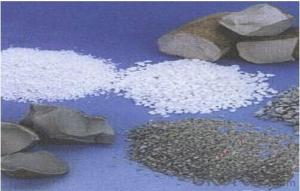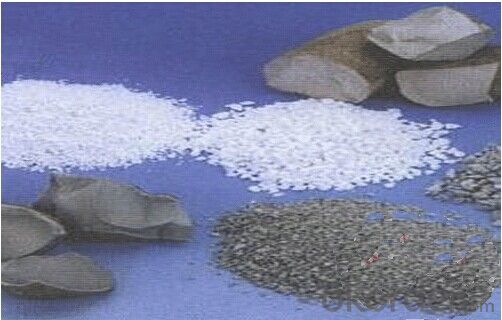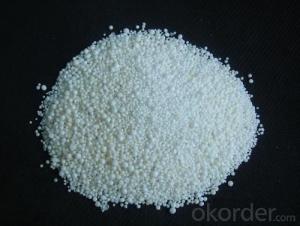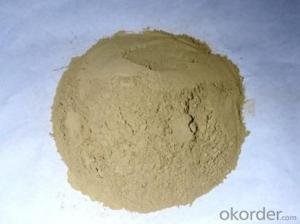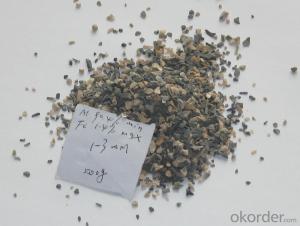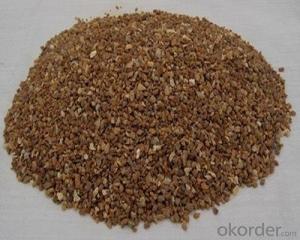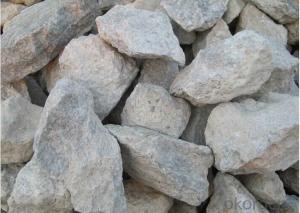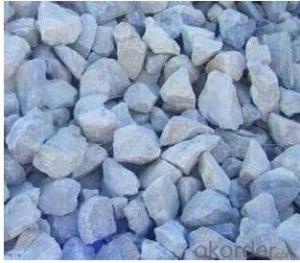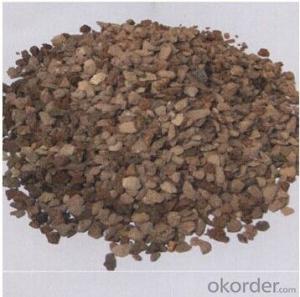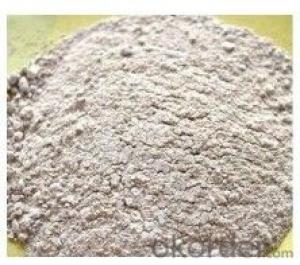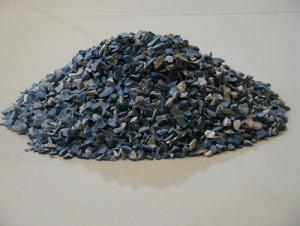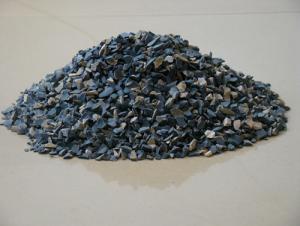Raw Materials for Refractory:Magnesite BOF Gunning Material
- Loading Port:
- China Main Port
- Payment Terms:
- TT OR LC
- Min Order Qty:
- -
- Supply Capability:
- -
OKorder Service Pledge
OKorder Financial Service
You Might Also Like
| ||||||||||||||||||||||||||||||||||||||||||||||||||||||||||||||||||||||||||||||||||||||||||||||||||||||
| | ||||||||||||||||||||||||||||||||||||||||||||||||||||||||||||||||||||||||||||||||||||||||||||||||||||||
| | ||||||||||||||||||||||||||||||||||||||||||||||||||||||||||||||||||||||||||||||||||||||||||||||||||||||
Production Technics:
1.Based on high pure magnesia, as the main raw material;
2.adding various compound anchoring agent, ;
3.By mixing and refining.
Production Features:
1.High refractoriness ,excellent resistance for spall , high tap density
2.Easy to spry and sinter, Adhesive rate reach 94% , low rebounding ;
3.Long service life ,once can last 10-24 hours ;
4.Minimum pollutants
Construction method :
1.using quantity:for 30 tons converter, one ton /time
2.Using method : to fill Gunning Mass into the spraying tank (compressed air without water under 2.2-0.4pa ); and then spray to the part need to be repair .
3.After spraying , there will be 20 minutes for sintering ;
4.Note: if somewhere occur weak situation,must stick the brick firstly ,and then spray again .
- Q: Who knows about the fire endurance of A grade fireproofing glass doors?
- Fire doors and windows are divided into grade A, B and C according to the real national situation, also the minimum fire endurance has been stipulated, namely, the minimum fire endurance of grade A is 1.50 h, that of grade B and C are 1.00 h and 0.50 h respectively. There are wooden fire doors and steel fire doors. The main purpose of it is to reach the time that fire resistance should last. But door?closers are required to install. The fire endurance of A grade wooden fire doors should be no less than 90 min, and that of B grade fire doors should be no less than 60 min, that of C grade fire doors should be no less than 30 min! ! !
- Q: Who can tell me what is neutral refractory?
- Neutral refractories refer to the refractory materials which will not react greatly with both acidic and basic slag at high tempreratures. Such as carbon refractories and chromite refractories. The main components include carbon, silicon carbide, aluminum oxide, chromium oxide and other trivalent oxides, such as carbon refractories and chrome refractories, etc. Strictly speaking, neutral refractories refer only to the carbonaceous refractories, including carbon brick and graphite silicon carbide products, etc.
- Q: I wanna ask about the building insulation materials fire rating?
- In China, the main external insulation materials are divided into level A, level B1, level B2 and level B3. According to the current "Combustion Performance Classification Method of Building Materials", level A thermal insulation material is incombustible material and inorganic insulation material. However, there are few level A thermal insulation material on the current market, only glass wool, rock wool board, foam glass and vitrified micro bead. However, compared with level A insulation material, the organic insulation materials are popular in the market. Level B insulation material can be divided into three levels, level B1 is flame-retardant, level B2 is flammable, and level B3 is flammable. Level B1 nonflammable thermal insulation material is determined by the fire endurance of the material, in addition, different parts of material is divided differently! More common is EPS / XPS insulation boards which have added flame retardant through special treatment. B2 level of combustible insulation materials, common to EPS expanded polystyrene foam insulation board and XPS board, that is, we often say that the general board. The ignition point of this material is very low, and it will release a large amounts of harmful gases in the combustion process. level B3 flammable insulation material is a kind of thermal insulation material which mainly made of polyphenyl foamed. Since this material is highly flammable, it has been eliminated. Civil construction insulation materials, popular building insulation materials in China's current market are mainly made by three organic foam, such as EPS (molded polystyrene board), XPS (extruded polystyrene board) and PU (polyurethane)
- Q: Does the refractory material used in steelmaking all refer to refractory brick?
- Besides refractory brick, it also refers to unshaped refractories like fire clay and castables.
- Q: Which brand of AAA refractory is good?
- The most famous is fire dragon. The Morgan and Lu Yang are all very good at making common thermal insulation material. The price is not very expensive, and the quality is comparatively good. The refractories are capable of good thermal shock resistance ability and chemical errosion resistance ability It is a non-metal material with a low heat conductivity coefficient and expansion coefficient. It requires high temperature in nature. The production base of silicious thermal insulation board is difficult to transport raw material. The silicious thermal insulation board is a high temperature thermal insulation material with the raw material of non-porous refractory?aggregate and porous refractory?aggregate, organic fiber and inorganic fiber.
- Q: What are Grade-A waterproof inorganic thermal insulation materials?
- There is a market confusion in Grade-A waterproof inorganic thermal insulation materials. The products mainly include Grade-A monomer material like roc wool and ultra-thin insulation board and Grade-A composite material. Many Grade-B materials wraaped with calcium silicate board or foam cement belongs to Grade-A material, such as phenolic aldehyde composite. Some foamed materials with filling also belongs to Grade-A material. However, there are few products with Grade-A qualification. Many manufacturers are working on the margins of the records with Grade-A fireproofing performance examining report. But this situation will not be too long.
- Q: Why the corundum can be used as refractory
- Because the main component of corundum is aluminum oxide!
- Q: Fire insulation and fireproof insulation board materials What is the difference in performance?
- What is the difference between fireproof insulation board and fireproof materials in their performance? Fireproof Materials prevents burning through insulating while others by chemical reactions. The overall heat conductivity coefficient of Insulation materials are generally lowered by thermal conductivity of the material itself and the structure of the material. Inorganic active insulation material uses ordinary cement, insulation stone, calcium powder, platycodon grandiflorum as the main raw material, produced after numerous tests with advanced production technology and chemical technology. Products features fire retardant,anti-aging properties and stable performance, low deformation coefficient, environmentaly friendly, compatible with the wall base layer and plastering layer. It has good security and stability and is as durable as ordinary buildings. Strong fire resistance: Fire insulation board is made of inorganic materials (cement), fireproofing level reaching to A1. As it does not burn, it is fireproof.
- Q: What's the A class fireproof and thermal inuslation matertial for external wall?
- First, external wall thermal insulation material: 1. silicate insulation material; 2. glue powder polyphenyl granule; 3. cement cystosepiment with the use of steel wire gauze (polystyrere); 4. extruded sheet; Second, roofing materials: 1. xps extruded sheet; 2. EPS foam board; 3. perlite and perlite brick; 4. vermiculite and vermiculite brick; Third, materials for heating power and air conditioners: polyurethane, rubberplastic sponge, polyethylene, polystyrene foam, glass wool, rock wool; Fourth, steel structure material: polystyrene, extruded board, polyurethane board, glass cotton lap felt, etc.
- Q: What is the limit of fireproof rolling shutter?
- According to the national standard 14102-2005 GB standard, the provisions of 14102-2005 GB specify that: According to provision 14102-2005 GB: If fire resistance limit of fire resisting shutter is no less than 3 hours, it is AAA fireproof rolling shutter. Therefore, the fire resistance limit of AAA grade fireproof rolling shutter should be 3 hours.
Send your message to us
Raw Materials for Refractory:Magnesite BOF Gunning Material
- Loading Port:
- China Main Port
- Payment Terms:
- TT OR LC
- Min Order Qty:
- -
- Supply Capability:
- -
OKorder Service Pledge
OKorder Financial Service
Similar products
Hot products
Hot Searches
Related keywords
